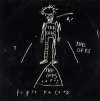Untitled
The following prints, follow early ‘80s paintings by Jean-Michel Basquiat, handling his two most significant motifs—the skull and the crown. Implying royalty, the crown symbol was used by Basquiat to celebrate Black excellence; it is bittersweet, however, when frequently paired with his macabre skull motif, alluding to the harsh realities of being Black in America.
Jean-Michel Basquiat Untitled for sale
Sell Your Art
with Us
with Us
Join Our Network of Collectors. Buy, Sell and Track Demand
Meaning & Analysis
This grouping of prints handle two of the most significant motifs in the Basquiat oeuvre: the skull and the crown.
Head recalls Skull, the painting which set records when it sold at auction for $110.5m in 2017. This is a prime example of Basquiat’s, torturous, skull-like depiction of faces, with the paint appearing to be aggressively slathered onto the canvas rather than carefully applied. Much like in Skull, the image appears to depict the interior of a skull as well as the surface of the face. In places, the thick black lines could represent the knots of the brain or an ear. The image evokes a feeling of fear and morbidity, not unlike Edvard Munch’s Scream.
The motif of the crown, which takes centre stage in Per Capita and is also visible in Rinso, is perhaps the most recognisable element of Basquiat’s visual language, seen in paintings works as Red Kings and Versus Medici. With its powerful association with royalty and richesse, It was primarily used to recognise the regard in which the artist held the Black heroes to which his art pays constant tribute, as artist Francesco Clemente notes: “Jean-Michel’s crown has three peaks, for his three royal lineages: the poet, the musician, the great boxing champion. Jean measured his skill against all he deemed strong, without prejudice as to their taste or age.” The crown motif also appeared in the famous album cover designed by Basquiat for hip-hop artist the Notorious BIG in the form of the musician wearing a plastic crown. Following the artist’s death in 1988, close friend Keith Haring painted A Pile of Crowns for Jean-Michel Basquiat to memorialise the artist.
The use of the crown motif in both Rinso and Per Capita can be interpreted as Basquiat’s representation of the deification of materialism and corporate greed in American society. In the latter image, the crown sits above ‘ASBESTOS’ in a reference to the Asbestos scandal which saw corporations cover up the harmful effects of the profit-generating product in the construction industry. The asbestos crown covers a range of sketches depicting religious and mythical icons, suggesting the victory of a quasi-religious and ruthless materialism over centuries-old belief systems. Another work of anti-capitalist critique, Rinso references the soap product of the same name which was a household staple in American households of the era. The work can be interpreted as a dark parody of infomercials, with the double entendre of ‘whitewashing action’ nodding to the erasure of Blackness in American culture.




